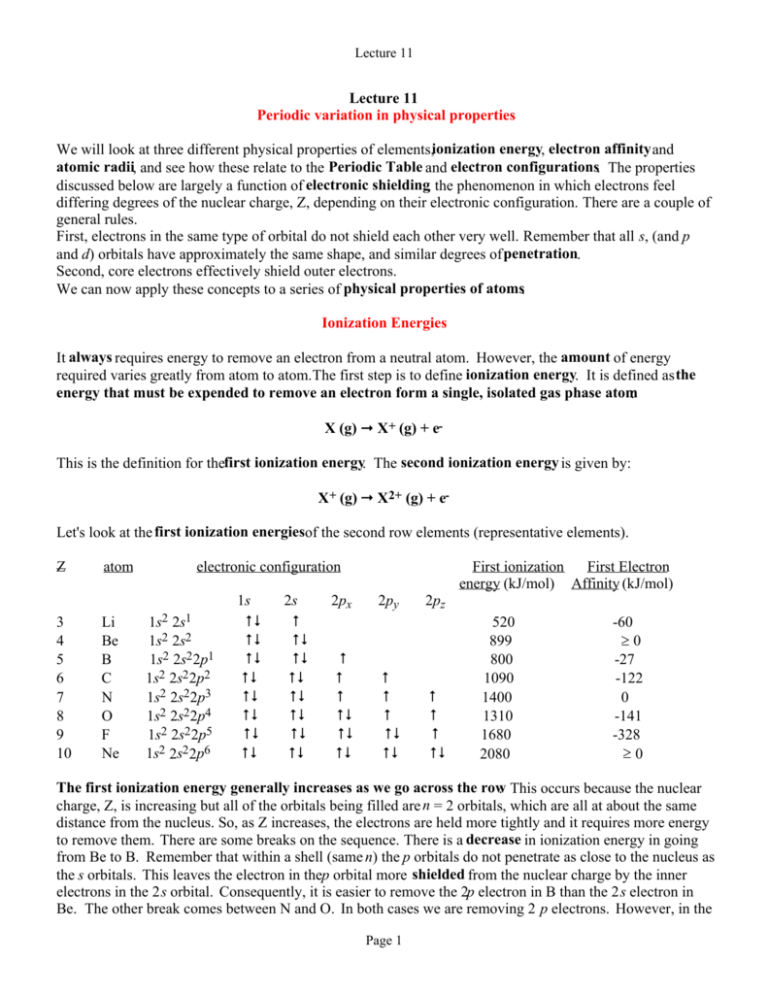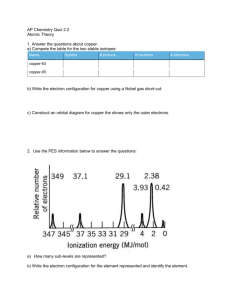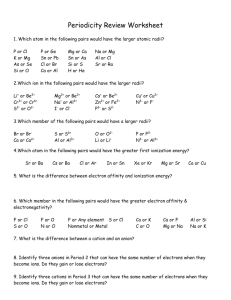Lecture 13
advertisement

Lecture 11 Lecture 11 Periodic variation in physical properties We will look at three different physical properties of elements,ionization energy, electron affinity and atomic radii, and see how these relate to the Periodic Table and electron configurations. The properties discussed below are largely a function of electronic shielding, the phenomenon in which electrons feel differing degrees of the nuclear charge, Z, depending on their electronic configuration. There are a couple of general rules. First, electrons in the same type of orbital do not shield each other very well. Remember that all s, (and p and d) orbitals have approximately the same shape, and similar degrees of penetration. Second, core electrons effectively shield outer electrons. We can now apply these concepts to a series of physical properties of atoms. Ionization Energies It always requires energy to remove an electron from a neutral atom. However, the amount of energy required varies greatly from atom to atom. The first step is to define ionization energy. It is defined as the energy that must be expended to remove an electron form a single, isolated gas phase atom: X (g) X+ (g) + eThis is the definition for thefirst ionization energy. The second ionization energy is given by: X+ (g) X2+ (g) + eLet's look at the first ionization energiesof the second row elements (representative elements). Z 3 4 5 6 7 8 9 10 atom Li Be B C N O F Ne electronic configuration 1s2 2s1 1s2 2s2 1s2 2s2 2p1 1s2 2s2 2p2 1s2 2s22p3 1s2 2s22p4 1s2 2s2 2p5 1s2 2s2 2p6 1s 2s 2px First ionization First Electron energy (kJ/mol) Affinity (kJ/mol) 2py 2pz 520 899 800 1090 1400 1310 1680 2080 -60 ≥0 -27 -122 0 -141 -328 ≥0 The first ionization energy generally increases as we go across the row. This occurs because the nuclear charge, Z, is increasing but all of the orbitals being filled are n = 2 orbitals, which are all at about the same distance from the nucleus. So, as Z increases, the electrons are held more tightly and it requires more energy to remove them. There are some breaks on the sequence. There is a decrease in ionization energy in going from Be to B. Remember that within a shell (same n) the p orbitals do not penetrate as close to the nucleus as the s orbitals. This leaves the electron in thep orbital more shielded from the nuclear charge by the inner electrons in the 2 s orbital. Consequently, it is easier to remove the 2p electron in B than the 2 s electron in Be. The other break comes between N and O. In both cases we are removing 2 p electrons. However, in the Page 1 Lecture 11 case of oxygen we have paired electrons. These two electrons repel each other more strongly than unpaired electrons in different orbitals, making it easier to remove the oxygen electron. This same trend is observed in all subsequent rows of the Periodic Table. Shown below is a chart of the first ionization energies of the elements through radon. As the Period increases, the ionization energies decrease.As n increases, the orbitals become larger (further from the nucleus) and it becomes easier to remove electrons from them. Notice that the noble gases have the highest ionization energies in each Period. This is due to the stability of having full valence shells. The first four ionization energies are shown, below, for aluminum, Z = 13. Al : 1s2 2s2 2p6 3s2 3p1 reaction Al (g) Al+ (g) + eAl+ (g) Al2+ (g) + eAl2+ (g) Al3+ (g) + eAl3+ (g) Al4+ (g) + e- Ionization Enrgy (kJ/mol) 580 1815 2740 11,600 electron removed 3p1 3s2 3s1 2p6 Core electrons are much more difficult to remove than valence electrons, those in the highest orbital. This is an indication of the importance of valence shell electrons in chemical reactivity.They are the electrons involved in electron transfer and in electron sharing. The inner core electrons are too firmly held to be reactive. Electron Affinities The electron affinity is defined as the change in energy (ΔE), when the following gas phase reaction occurs: X (g) + e- X- (g) The change will be negative (ΔE < 0) when is energy is given off. This indicates that the potential energy of the system is lowered. This stabilizes the system. The chart above lists the electron affinities for elements Page 2 Lecture 11 IA - VIIIA. A large, negative value indicates that the anion (negatively charged product) is stable. A comparison of the electronic configuration and the electron affinity explains the trends. Fluorine has a large, negative electron affinity, indicating that it very easy for F to accept an electron to become F-. The 1 s and 2 s orbitals are full and fluorine needs only one electron to completely fill the 2 p orbitals. This gives it a very high degree of electron affinity. Compare this to nitrogen with an electron affinity of zero. It has the 1 s and 2 s orbitals full, and half-full 2 p orbitals. Adding another electron would introduce electron-electron repulsion in the newly paired electrons, making it unfavorable.Oxygen has a negative first ionization energy, but not much more negative than carbon. The first added electron will bring it closer to a noble gas electron configuration, but it will mean an increase in the electron-electron repulsion as electrons become paired. This is even more obvious when one looks at oxygen's second ionization energy O- + e- O2- , which has a large positive value, again because of the repulsion between paired electrons. Group IIA elements (like Be in the chart) have very small or even positive electron affinities. This indicates that they do not tend to gain electrons. The electron configuration shows that the s orbitals are full, and that added electrons would go to the p orbitals, which are effectively shielded by the s orbitals, lowering the effective nuclear charge felt by added electrons. The Noble gases also have very small electron affinities. This would be expected in light of their complete shells. Page 3








